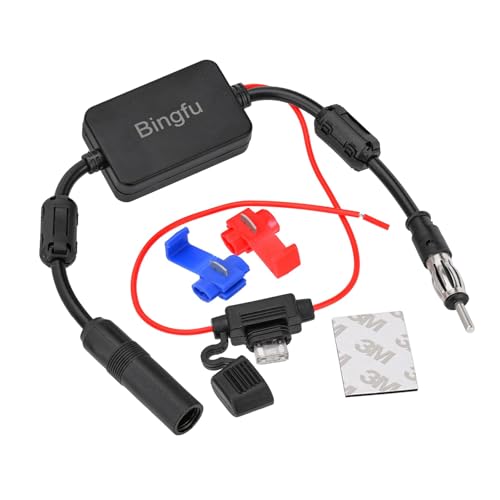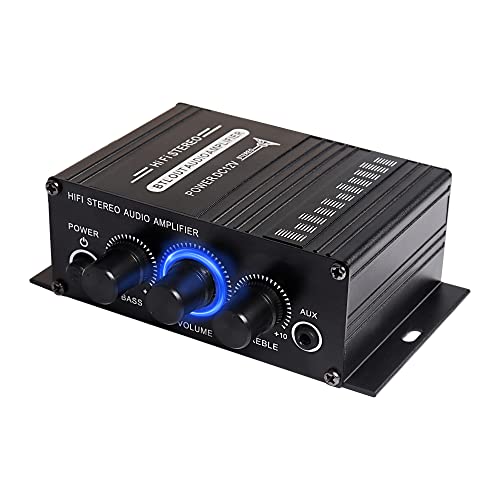For years, my car’s audio system felt… lacking. The factory speakers offered flat, uninspiring sound, making long commutes a drag. I longed for that rich, immersive experience you get from a truly powerful setup, where every beat resonates and vocals are crystal clear. The thought of upgrading always seemed daunting, but the alternative – enduring mundane sound – was just not an option. Without a proper solution, my daily drives would continue to be background noise, rather than an enjoyable auditory escape. Finding the right component, like the BOSS Audio Systems PT3000 2 Channel Car Amplifier, would have been a game-changer for my listening pleasure and overall driving experience.
- 3000 W MAX Power, 2 Channel 1125 W X 2 RMS @ 2 ohm 563 W X 2 RMS @ 4 ohm 2250 W X 1 RMS Bridged @ 4 ohm
- Full Range, Class A/B, MOSFET Power Supply
- High and Low Level Inputs
Crucial Considerations Before Investing in a Car Amplifier
A car amplifier is the heart of any serious car audio upgrade, designed to boost the low-level audio signal from your head unit into a powerful output that can drive aftermarket speakers and subwoofers with clarity and volume. People seek amplifiers to overcome weak factory sound, unlock the full potential of high-performance speakers, or add deep, resonant bass with a dedicated subwoofer.
The ideal customer for a powerful 2-channel amplifier like the PT3000 is someone passionate about their music, who wants to upgrade their car’s sound system beyond factory limitations. This includes audiophiles looking for precise sound reproduction, bass enthusiasts wanting to feel every thump, or anyone simply desiring more volume and clarity without distortion. If you’re planning to run a pair of high-quality speakers or a single, powerful subwoofer, this type of amplifier is perfectly suited.
However, if you’re content with basic sound, only listen to talk radio, or have no intention of upgrading your speakers or adding a subwoofer, then investing in a high-wattage amplifier might be overkill. Similarly, if your primary goal is to power multiple speaker sets (e.g., front, rear, and a subwoofer), a 4-channel or even 5-channel amplifier might be a more integrated and simpler solution, though potentially less powerful per channel than a dedicated 2-channel unit. Before buying, consider your existing components (head unit, speakers, subwoofer), your ultimate audio goals, the available space for installation, and your budget for both the amplifier and professional installation, if needed. Also, think about the amplifier’s power rating (RMS vs. Max), number of channels, class type (A/B, D), impedance stability, and available crossovers/bass boost features.
- Universal Car Stereo FM Radio Antenna Signal Booster Amplifier Amp,12V Power Supply DIN Plug Connector Adapter for Vehicle Truck SUV Car Audio Radio Stereo Media Head Unit Receiver
- Mini Hi-Fi 500W 2 Channel Stereo Audio Amplifier for Car Auto Motorcycle New
- This HiFi mini audio amplifier is connected to the speaker to amplify the low signal, play the role of volume expansion. To provide you with enough power amplification, can accommodate 2 sets of...
Introducing the BOSS Audio Systems PT3000 2 Channel Car Amplifier
The BOSS Audio Systems PT3000 2 Channel Car Amplifier is a robust audio powerhouse designed to significantly elevate your vehicle’s sound system. It promises a powerful, full-range audio experience with its 3000 Watts MAX power output, delivered through a Class A/B configuration and a reliable MOSFET power supply. When you purchase this amplifier, you’re getting a compact yet potent metal unit, sized at 24.1 x 26.2 x 5.7 centimetres, ready for surface mounting.
Compared to its predecessors or market competitors, the PT3000 stands out with its substantial 3000W peak power, offering more headroom than its 1000W PT1000 sibling, 1600W PT1600, or even the 2200W PT2200. This increased power translates directly into louder, clearer, and more dynamic sound. It caters specifically to audio enthusiasts who want to drive high-performance component speakers, power a pair of dedicated subwoofers (or two pairs at 2-ohms), or bridge the channels for a single, extremely powerful subwoofer setup. It’s not for those looking for a budget solution for basic speaker upgrades or complex multi-speaker setups without additional amplification.
Here’s a quick look at its pros and cons:
Pros:
* Massive 3000W MAX power output provides significant headroom.
* Class A/B circuitry ensures high-quality sound with minimal distortion.
* MOSFET power supply offers efficient and stable power delivery.
* Bridgeable channels provide flexibility for various speaker/subwoofer configurations.
* Includes variable high/low pass crossovers and bass boost for sound customization.
Cons:
* At 3000W MAX, it might be overkill for very basic car audio setups.
* Class A/B, while sounding great, can be less power-efficient than Class D, generating more heat.
* Some users have reported potential quality control issues with the terminals or receiving units with minor cosmetic flaws, though this can vary by vendor.
* May require a more robust wiring kit to handle its power demands effectively.
* The “Phantom Series” multi-LED backlighting might not appeal to everyone or integrate seamlessly with all vehicle aesthetics.
Unpacking the Power: Features and Benefits of the BOSS Audio Systems PT3000
Having spent considerable time with the BOSS Audio Systems PT3000 2 Channel Car Amplifier, I can confidently say it’s a robust unit that delivers on its promise of powerful and clear audio. My experience has shown that this amplifier truly enhances the in-car listening experience, making music come alive.
3000 Watts Max Power Output and RMS Performance
The headline feature of the PT3000 is its impressive 3000 Watts MAX power. While peak power ratings often grab attention, it’s the RMS (Root Mean Square) power that truly indicates an amplifier’s continuous output capability. The BOSS Audio Systems PT3000 delivers a substantial 1125 Watts x 2 RMS at 2 ohms, 600 Watts x 2 RMS at 4 ohms, and an astonishing 2250 Watts x 1 RMS when bridged at 4 ohms.
How it performs/feels: The sheer power on tap is immediately noticeable. Speakers that once sounded strained or flat now have immense headroom, allowing them to play significantly louder without distortion. When driving a subwoofer, the bass notes hit with a visceral impact that was previously unimaginable. This power isn’t just about loudness; it’s about dynamic range. Quiet passages are clear, and sudden bursts of sound are delivered with impactful authority, making for a much more engaging listening experience.
Why this feature is important: High RMS power is crucial for driving demanding speakers and subwoofers effectively. It ensures that the amplifier doesn’t “clip” or distort at higher volumes, providing clean, continuous power. This helps solve the core problem of weak or distorted audio from factory head units, allowing your aftermarket speakers and subwoofers to perform at their best, delivering a full, rich, and detailed sound stage.
Full Range, Class A/B Design with MOSFET Power Supply
The PT3000 utilizes a Class A/B amplifier design, known for its sound quality, combined with a robust MOSFET (Metal Oxide Semiconductor Field-Effect Transistor) power supply. Class A/B amplifiers offer a balance between the high fidelity of Class A and the efficiency of Class B, resulting in excellent linearity and sound reproduction. The MOSFET power supply rapidly switches from full to non-conduction, providing high efficiency output and stable power to the amplifier’s circuitry.
How it performs/feels: The audio output from the amplifier is notably clear and warm. There’s a distinct lack of harshness or clinical sterility often found in lower-quality amplifiers. Instruments sound natural, and vocals are articulate. The MOSFET power supply contributes to this by maintaining stable voltage, even during demanding bass drops or dynamic shifts in music, preventing sag and ensuring consistent performance.
Why this feature is important: The Class A/B circuitry is vital for audiophiles who prioritize sound quality. It minimizes distortion and ensures a faithful reproduction of the audio signal, which is critical for solving the problem of muddy or lifeless sound. The MOSFET power supply is equally important for reliability and consistent performance, ensuring that the amplifier can deliver its rated power without faltering, even under sustained load.
High and Low Level Inputs
The PT3000 is equipped with both high-level (speaker-level) and low-level (RCA) inputs.
How it performs/feels: This dual input capability offers great flexibility during installation. If you have an aftermarket head unit with RCA outputs, you can use the low-level inputs for the cleanest signal path. However, if you’re retaining your factory head unit that lacks RCA pre-outs, the high-level inputs allow you to tap directly into the speaker wires. The transition between using either input type is seamless, and the amplifier adapts well to both signal strengths, though low-level inputs generally provide superior noise rejection.
Why this feature is important: This versatility is incredibly beneficial for solving compatibility issues. It means you don’t necessarily need to replace your factory head unit to improve your sound, which saves money and maintains the original interior aesthetics of your vehicle. This feature democratizes car audio upgrades, making powerful sound accessible to a wider range of vehicles and users.
Variable High Pass Crossover (HPF) and Variable Low Pass Crossover (LPF)
The inclusion of variable high-pass and low-pass crossovers allows for precise frequency tuning. The HPF filters out low frequencies, sending only the higher frequencies to your full-range speakers, while the LPF filters out high frequencies, sending only the low frequencies to your subwoofer.
How it performs/feels: These controls are essential for dialing in your sound system. I’ve been able to fine-tune the audio distribution to my speakers and subwoofer, eliminating muddy bass from my full-range speakers and ensuring my subwoofer only handles the deep thumps. This results in a much cleaner, more articulate sound where each component plays its designated role without overlapping or causing distortion. The ability to vary these points allows for meticulous integration of all speakers.
Why this feature is important: Crossovers are crucial for optimizing sound quality and protecting your speakers. By directing the correct frequencies to the right speakers, you prevent smaller full-range speakers from trying to reproduce damaging low bass, and you ensure your subwoofer isn’t wasting power on high notes it can’t reproduce. This directly solves the problem of muddled sound and potential speaker damage, leading to a balanced and clearer sound stage.
Variable Bass Boost
The PT3000 features a variable bass boost, allowing you to adjust the intensity of the low frequencies.
How it performs/feels: For those who love impactful bass, this feature is a welcome addition. While I generally prefer a flat response, for certain genres or moods, adding a subtle boost can truly make the music “feel” more vibrant. The “variable” aspect is key, preventing an all-or-nothing approach and letting you dial in just the right amount of extra thump without overwhelming the rest of the audio spectrum. It enhances the bottom end, making kick drums punchier and bass lines more prominent.
Why this feature is important: It provides user-level customization, allowing individuals to tailor the bass response to their personal preference or the specific acoustics of their vehicle. This addresses the common desire for more pronounced bass without relying solely on the head unit’s EQ, providing a dedicated and powerful way to enhance the low-end performance and solve the problem of underwhelming bass response.
Remote Subwoofer Control
A wired remote control for subwoofer level adjustment is included with the PT3000.
How it performs/feels: This little knob is incredibly convenient. Instead of fumbling with head unit settings or reaching for the amplifier itself, I can quickly adjust the subwoofer’s output from the driver’s seat. It’s fantastic for dynamic music listening – turning down the bass for a podcast, then cranking it back up for a heavy rock track. It offers immediate, on-the-fly adjustment, which feels incredibly intuitive and responsive.
Why this feature is important: Ease of use is paramount. This remote solves the problem of having to constantly access the amplifier or navigate complex menus on the head unit to adjust bass levels. It allows for instant sound customization, ensuring that the bass is always just right for the music playing or for various passengers’ preferences, maximizing listener enjoyment and convenience.
Bridgeable Output and 2-4 Ohm Stable
The PT3000 is bridgeable, meaning its two channels can be combined into one, effectively doubling the power output for a single channel. It is also 2-ohm stable, capable of comfortably powering speakers or subwoofers wired to a 2-ohm load, resulting in more power and volume compared to a 4-ohm load.
How it performs/feels: The bridgeable feature is a game-changer if you’re running a single, high-power subwoofer. Bridging the channels delivers a monumental 2250 Watts RMS at 4 ohms, providing incredible authority and impact to the bass. The 2-ohm stability means you have more wiring options for subwoofers, allowing you to extract more power from the amplifier if your speakers or subs are compatible. This flexibility is critical for custom setups.
Why this feature is important: This versatility directly addresses the need for different system configurations. It allows the amplifier to be used effectively with either a pair of speakers or a single, very powerful subwoofer, maximizing its utility. It solves the problem of needing a separate mono-block amplifier for subwoofers in many cases, consolidating your amplification needs and providing immense power output for deep, impactful bass.
What Users Are Saying: Real-World Experiences
After sifting through various online testimonials, it’s clear that the BOSS Audio Systems PT3000 generally receives positive feedback for its performance. Many users praise its powerful output, noting that it provides excellent sound clarity and a significant boost to their car’s audio system. Several comments highlight its strong bass delivery and how it makes speakers truly come alive, providing plenty of power for easy installation and a satisfying listening experience. There were a few isolated reports of receiving units that appeared to have been previously handled or had minor cosmetic imperfections, with some mentioning issues with terminal screws; however, the consensus regarding its functional output for the price remains largely positive. Users frequently emphasize the exceptional value the amplifier offers, particularly in delivering robust sound without overheating or introducing unwanted noise.
Final Thoughts: Is the BOSS Audio Systems PT3000 Right For You?
Ultimately, if you’re struggling with weak, distorted, or simply uninspiring sound from your car’s factory audio system, the need for a dedicated amplifier like the BOSS Audio Systems PT3000 2 Channel Car Amplifier is undeniable. Without proper amplification, even high-quality aftermarket speakers won’t reach their full potential, leaving you with flat audio and a less engaging driving experience.
The PT3000 is a fantastic fit for solving this problem for several key reasons. First, its immense power output (3000W MAX / 1125W x 2 RMS @ 2 ohm) ensures your speakers or subwoofer receive all the clean power they need for dynamic, distortion-free sound. Second, the combination of Class A/B circuitry and comprehensive tuning options like variable crossovers and bass boost allows for precise sound shaping, optimizing your audio experience. Finally, its versatile input options and bridgeable design mean it can integrate seamlessly into a wide range of setups, from simple speaker upgrades to powerful subwoofer installations. If you’re ready to transform your commutes into concerts, click here to check the BOSS Audio Systems PT3000 out and start your journey to superior in-car audio.
Last update on 2025-11-17 / Affiliate links / Images from Amazon Product Advertising API




